As for our economy, there isn’t anything to be proud of. We say that there is a lack of natural resources in our country, but there are rare fields, where we have developments. for instance, mineral water, brandy and stone production. During the past couple of years (i.e. during Kocharyan’s term as president) something new that has come up and is spoken about a lot- the two-figure mark of our economic development. When foreigners visit our country, after taking them to sightseeing places we always inform them about the rapid economical growth of the country. As for the foreigners, they are surprised to learn this and often wonder how we can have such rapid growth what with the blockade and the lack of rich natural resources. They also wonder why citizens complain about these authorities if there is good economical growth.
As Armenians say, “it is impossible to understand Armenia logically”.
The National Statistics Service (NSS) of Armenia has already published the economic tendencies of the first trimester of 2006. Alas, we don’t have two-figure economical growth yet. The growth mark of these three months compared to the same mark last year increased only by 8%. This is not bad; even many European countries don’t have this. But for us this mark is not good. But there is no reason to worry because the economy in March was good: the growth mark in March compared to that of February covered 10,6%. If the economy keeps growing with the same marks of March, we will have a two-figure economical growth. On the basis of the mark in March we may assume that this growth will be higher during the coming months. For instance, in the construction field the growth in March compared to February covered 61,4% (this field is the main part of economical growth). As for the marks of the first trimester, the growth mark covered 25,2% compared to that of the previous three months.
In January-March, 2006, the growth mark in the agriculture field covered 3,5%. According to specialists, poor weather conditions of the past days will affect our agriculture.
There is good development in service sector as well. The growth of this field compared to the first three months of last year covers 22,1%. Whereas agricultural and construction fields depend on seasonal changes, there are fields that are not subject to such changes. The leading field among these is production. This field doesn’t grow any more, on the contrary, it’s going down. The production field has gone down by 4,7% during the first three months, and 0,6% more during March.
There is degradation in almost all fields of production. For instance, the NSS registered 6,3% degradation in energetic and water supply fields. The only energetic field that had growth is gas supply, but this is not national production because we use the gas supplied from Russia (14%).
As for mining, metal mining field degraded by 4,3%, while other mining fields grew by 39,2%. There is degradation in almost all other production fields. The fact that the cargo transportation capacities have gone down by 7,2% serves as proof.
As for foreign turnout of products, this field has gone up by 7% (it covers $606,4 million) compared to the same time last year. But this growth is not good for us, because in parallel to this, the number of exports was reduced by 5,6%. As for import, it increased by 13,6%. During the first trimester, exports covered $184,4 million and imports were $422 million. This means that during these three months our country “exported” 238 million dollars. If foreign trade goes on like this until the end of this year, the negative balance of our country will reach one billion dollars. We also pay attention to the list of the largest taxpayers. We may assume that importers get more profit now. The downfall of the U.S. exchange rate is good for importers. Recently this exchange rate was stable (450 AMD for 1 USD), but these past days it is going down slowly. The Central bank of Armenia predicted an exchange rate mark equal to 420 AMD for 2006. If things go at this rate, import capacities may increase.
How do citizens pay for the imported products? The average salary in Armenia is 55.000 AMD. Despite that, we are able to both keep the local demand stable and “export” 238 million USD out of the country. According to official information the public income in AMD increased by 2,7%, and expenses -by 5,1%. In fact we spend more than we produce. Several years ago some specialists thought it was a paradox, but now it is clear that the foreign transfers play a key role here. Last year foreign transfers to our country made up 1 billion USD. This is the main source of paying the mentioned money.
The last section of the NSS report concerning inflation is very suspicious. Everyone that buys products will agree with us that the prices for many products have increased since New Years. In spite of this, the report states that these prices have gone down by 1% during the first trimester compared to the same period last year. In addition, the inflation mark in March was about 4%.

